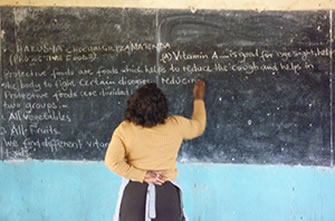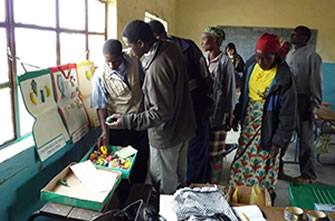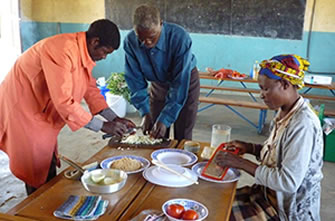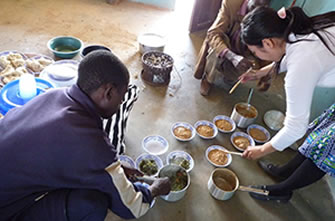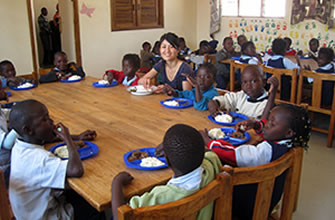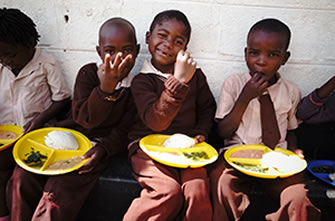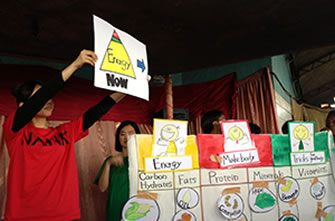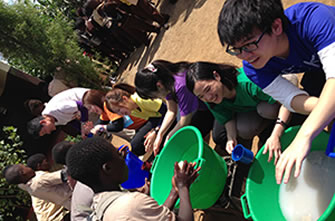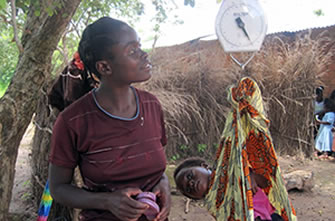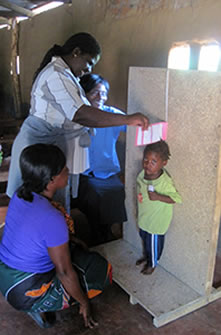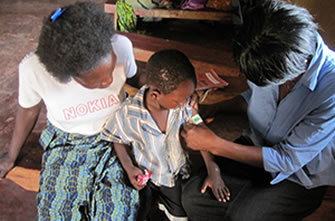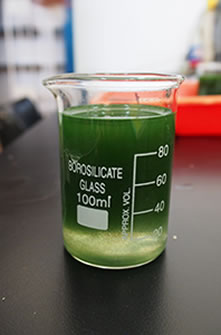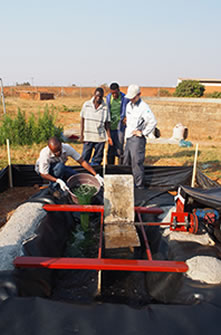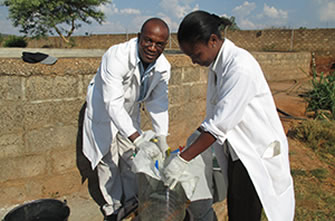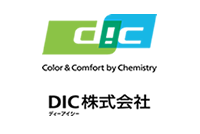What is lacking in Africa
This 2 minute video guides you to why we have to tackle the issue of malnutrition in Africa now. Let’s think together about the problem of malnutrition after watching this video.
Issues of Hidden Hunger
Every year, 3 million children die because of malnutrition
Many people associate the word “hunger”, with an image of underweight children. It is said that there are about 805 million people (one in nine people) suffering from hunger. However, to be exact, largely, there are two types of hunger. The first is acute malnutrition caused by sudden cut from the access to food, most of the time, due to conflicts or disasters. Often the times, the world collectively assists such countries for a certain period. This issue is well known since it is broadcasted in media often. However, in fact, there is another hunger issue just as serious as acute malnutrition in developing countries like Africa. It is called chronic malnutrition, or “Hidden Hunger”.
Chronic malnutrition is caused by micronutrient deficiency, such as vitamins and minerals. It can lead to increase in morbidity due to the deficiency in the immune system, or developmental disorders in the brain and the body. However, chronic malnutrition has not been recognized as the main theme in development area for a long time, since there is no prominent symptom in appearance. As a result, among children under five years old, every year, 3 million of them die from diseases caused by chronic malnutrition. Even after they survive, developmental disorders of the brain and the body could lead to decline in the enrollment rate and employment rate, and thus the income in the future. Referring to this state, chronic malnutrition is also known as the “hotbed of poverty”.
People in developing countries are in need of the intake of the micronutrient such as the vitamins and minerals, and protein that helps to build a healthy body, in addition to carbohydrates, which account for the majority of food aid.
※1 FAO (2014) http://www.fao.or.jp/detail/article/1248.html
※2 JETRO (2010) “Research on Potential Needs of BOP Business: Nutrition in Ethiopia” (JPN only)
※3 The Lancet (2008) 「Maternal and Child Undernutrition」
※4 JETRO (2010) “Research on Potential Needs of BOP Business: Nutrition in Ethiopia” (JPN only)
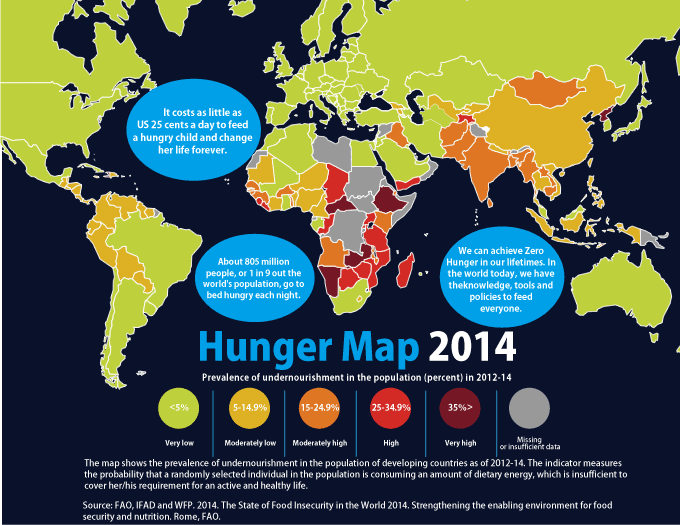
Aid to Fight against Malnutrition accounts for only 0.4% of development budget
Although the issue of chronic malnutrition has been long recognized among experts, it only started to gather attention globally after the publication of the series of research papers issued by a medical journal “The Lancet” in 2008. Since then, the movement to put the issue of chronic malnutrition as the center of development has widened. For example, in 2004, 2008, and 2012, “supply of nutrients” was listed as one of the most cost effective measures against international challenges in the Copenhagen consensus. The World Bank has also come to a similar conclusion in the report called “Repositioning Nutrition as Central to Development” in 2006. In 2010, an international conference for Scaling Up Nutrition (SUN) was organized by the UN agencies, bilateral aid agencies, and NGOs. In 2012, world leaders agreed to strengthen the effort to lower malnutrition at the G8 summit. Nevertheless, the budget of nutrition-related measures accounted for only 0.4% of the world total Official Development Assistance (ODA) in 2011.
What is needed in the future is not only campaigning to increase assistance on malnutrition, but also to build a successful model of curing malnutrition which can be an example showing the level of impact against the resource inputted, to guide the movement to an actual action.
※5 It is a project to seek establishing priorities for advancing global welfare using methodologies based on the theory of welfare economics, utilizing cost-benefit analysis.
ZAMBIA – The challenge in a country with one of the highest levels of stunting
Alliance Forum Foundation (AFF) has been working on the issue of chronic malnutrition in Zambia, using edible algae “Spirulina” known to be highly nutritious. By presenting a successful model of curing malnutrition in Zambia, AFF aims to contribute to connect the realization of “nutrition is important” to an actual action.
Zambia declared independence during the Tokyo Olympic Games of 1964 from former British colony, Northern Rhodesia. Many Japanese may still recall Zambia as the country which changed its name between the opening and closing ceremonies of the Olympics. There are more than 70 tribes in Zambia, still, it has been operating a stable government since independence by incorporating the multi-party system based on ethnic peace. Zambia having the headquarter of COMESA (Common Market for Eastern and Southern Africa), can also be called as the important base of political economy in the South and Eastern Africa.
Republic of Zambia

Alliance Forum Foundation selected Zambia as the first project country since it has 1) a stable government operation, 2) abundant water source indispensable for spirulina production, and 3) large number of children suffering from chronic malnutrition.
Stunting, the index of chronic malnutrition among children under five, is higher in Sub-Saharan Africa where Zambia is located at (38%), than the average of developing countries (32%). Zambia has one of the highest rates of stunting in Southern Africa which also has the highest among the Sub-Saharan states. In Zambia, about half of the children under the age of five are chronically malnourished. About 80% of the cause of death among the under-five children is due to illness caused by malnutrition. The urgency to increase the efforts to lower chronic malnutrition is very high. This is part of the reason why Zambia was selected as one of the priority initiatives countries of SUN.
In Zambia, Alliance Forum Foundation established a local office to launch the nutrition programme utilizing Spirulina, and has been active since 2009.
※5 Unicef (2007)「Progress for Children: A World Fit for Children Statistical Review」
Spirulina Project
Achieve Self-Sustainable Nutrition Programme by Locally Produced Spirulina
Alliance Forum Foundation (AFF) aims to lower the rate of malnutrition in Zambia through the use of Spirulina which is known to have high content of protein, vitamins, and minerals. Our project does not only avail Spirulina affordable through local production, but we also try to enhance the knowledge on nutrition among mothers by collaborating with the Zambian government. To achieve this aim, AFF has implemented three core sub-projects, namely, school meal project, effectiveness test project, and production project.
Our Project Design in Zambia
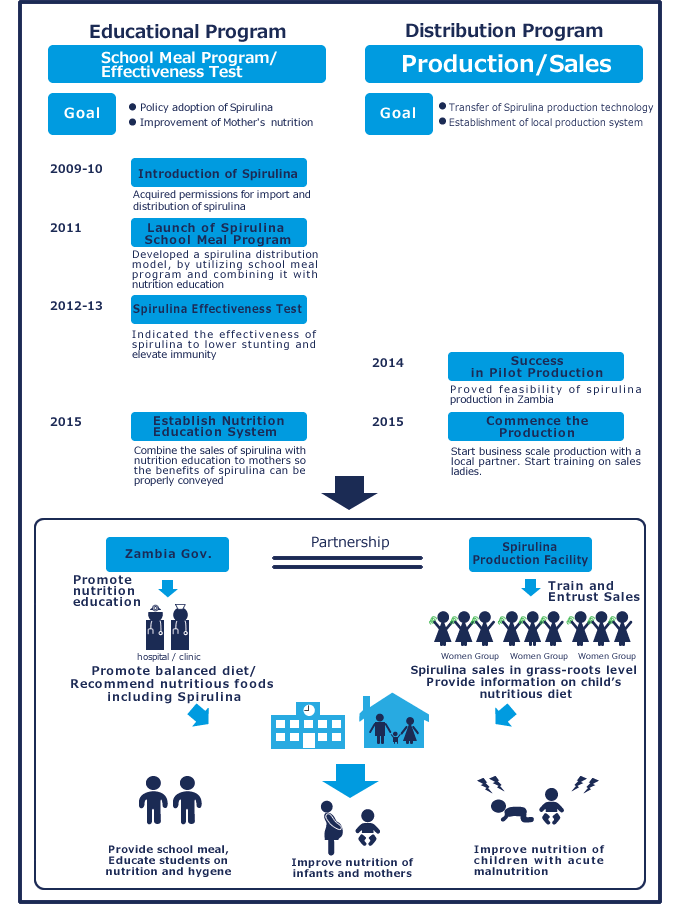
School Meal Project: Combine school meal with nutrition education
Typical Zambian dish consists with Nshima made from white maize, usually served with vegetables and source of protein, such as beans, meat, and fish. However, at lower income households, it is rare to have meat or fish. The variety of vegetables they can consume daily has also been very limited. Therefore, Spirulina, which can drastically enhance the nutrition balance of such simple meals just by one scoop of tea spoon, is useful. AFF has been implementing the school meal project to create a model that enables Zambians to eat Spirulina daily at right amount since 2011.
Typical Zambian dish consists with Nshima made from white maize, usually served with vegetables and source of protein, such as beans, meat, and fish. However, at lower income households, it is rare to have meat or fish. The variety of vegetables they can consume daily has also been very limited. Therefore, Spirulina, which can drastically enhance the nutrition balance of such simple meals just by one scoop of tea spoon, is useful. AFF has been implementing the school meal project to create a model that enables Zambians to eat Spirulina daily at right amount since 2011.
In advance of the school meal project, AFF held a tasting event of Spirulina dishes to find out the acceptability of the food, in collaboration with a NGO based in Zambia. We worked together with local women to develop Spirulina recipe. Spirulina was donated byDIC Corporation, which has been supporting our project since 2009. Recipe development was supervised by Japanese students studying medicine. The event was conducted in welcoming atmosphere, combined with entertainment of Zambian songs and dance performance. The relatively high acceptability of spirulina among residents encouraged us to further advance our project.
|
Before recipe development, participants studied about nutrition |
Before recipe development, participants studied about nutrition |
|
Scenes of Cooking |
Hope it tastes good! |
Based on the recipe chosen at the tasting event, we finally started our school meal project. The first school we had partnership with was the day care center accepting children diagnosed HIV/AIDS positive in 2011, the second school was the community school operated in a low income area in 2013, and since 2014 we are partnering with a special needs school in Lusaka.
|
School meal at the daycare center |
School meal at the community school |
In the school meal project, our primary emphasis is on respecting the local food culture, and educating students the importance of nutrition and therefore, the reason why spirulina are mixed in their meals. Spirulina is in green powder format, which easily dissolves in most recipes. On the contrary, it changes the color of the meal into green and gives off distinctive smell. To cope with this characteristic, we usually mix spirulina into green vegetable relish or strong colored relish such as red beans. In addition, we provide students nutrition and hygiene education in combination with games, songs, and pictures to promote understanding of the benefit of balanced diet, as well as hand and oral hygiene. Thorough nutrition education, students grow to accept eating spirulina, although of its unfamiliarity at first.
Alliance Forum Foundation will continue trying to validate the impact and establish a model for the nutritious school meal provision combined with nutrition education, to further expand the program to wider Africa.
|
Nutrition and hygine education was developed in collaboration with the school of medicine, department of Nursing, of Yokohama City University |
They also demonstrated how to wash hands in a proper way |
For more information on the School Meal Project check our annual report
Effectiveness Test Project: Realizing the Visibile Effects That Mothers can Notice
The Nutrition Policy which is renewed every five years by the Ministry of Health is one of the key elements to spread the benefits of Spirulina in the country. The policy does not only state the important area of nutrition to intervene, but also introduce locally available nutritious food to be promoted to mothers through clinics. For example, currently the policy recommends to mixing groundnuts powder and soya bean powder into baby porridge. Inclusion of Spirulina into government recommended food list could possibly lead to wider consumption of spirulina, which ultimately expected to contribute alleviating chronic malnutrition.
For inclusion of Spirulina, it is necessary to have evidence of impact on malnutrition. There is a similar study done in Brukina Faso, however not in Zambia. Therefore, Alliance Forum Foundation stepped forward to conduct its own effectiveness test in 2012.
In the first effectiveness test, 60 children chosen by random sampling method within the age range between 12 to 48 months were divided into two groups: 1) Treatment group eating Spirulina mixed porridge (30 children), and 2) Control group eating plain porridge (30 children). We measured children’s height, weight and mid-upper arm circumference (MUAC) monthly for over the period of nine months. We also checked the frequency of illiness, such as cold and diarrhea. At the end of the test, we found out that children in the treatment group had grown better in every indices, especially the difference in height growth was statistically significant. The test outcome provided proof on Spirulina effectiveness in improving stunting, therefore chronic malnutrition. In addition, the effect on improving immunity is anticipated as study showed that three times more children caught malaria in the control group in comparison with the target group.

|
Weight Scaling |
Height Scaling |
|
MUAC Scaling |
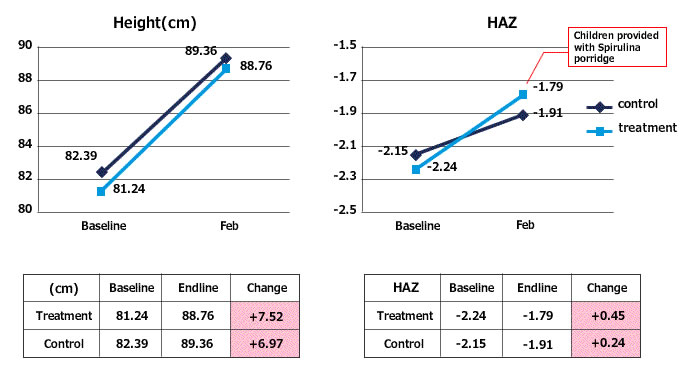
However, the most meaningful outcome was that the mothers noticed the effect of Spirulina. Although chronic malnutrition is known by “hidden”, changes in the body appearance, mothers of the treatment group noticed that their children became more energetic, had darker hair and healthier skin. It was very encouraging to also have mothers in the control group expressed their willingness to start mixing Spirulina into porridge after the effectiveness test was completed. It is Alliance Forum Foundation’s intention to yield not only numerically measured impact , but also visible impacts that can be noticed by mothers.
The thesis on the first effectiveness test result was published from the Institute of Development Studies (IDS) at the Sussex University of Britain in September 2014. The publication contributed to increase Zambian stakeholders’ awareness on effectiveness of Spirulina to reduce malnutrition.
The positive outcome of the first effectiveness test encouraged Alliance Forum Foundation and the local NGO partner to proceeded to further evaluate Spirulina’s effectiveness with a larger sample size to enhance the accuracy. If a similar result is yielded from the second test, the incorporation of Spirulina into the nutrition policy becomes more realistic. The second effectiveness test will be commenced in May 2015.

For more information on the first effectiveness test, Clinck the link for the full report.
Spirulina Production Project: Realizing the model of Local Production and Consumption
Pilot production was commenced in 2014 building on the success of effectiveness test and acceptance of spirulina at the school meal project. What is important in local production is 1) to achieve low cost production, and 2) complete skill transfer to local partners. The pilot production was conducted between August to December 2014 in order to assess the productivity under Zambian environment, and with the current available production technologies in Zambia. Since malnutrition is most prevalent among the lower income households, it is crucial to achieve an affordable price through trials in production. Pilot production was jointly conducted with experts at the School of Agricultural Science at the University of Zambia (UNZA). We aim to develop this partnership further so that UNZA will become the hub of research and skill transfer of Spirulina production in Zambia.
Prior to the commencement of the pilot production, the Spirulina seedlings were imported from a Malagasy research institute. At the UNZA lab, Alliance Forum Foundation and technicians from DIC Lifetech instructed the experts on how to take care of Spirulina along with many different ways to measure the volume and quality of Spirulina. During the capacity development period, though it was completely new experience, UNZA experts gradually acquired the Spirulina production management skills so that they can handle tasks by their own in the future
When Spirulina density reaches to certain level in the lab, it was moved to an outdoor pool. The main objective of outdoor production was to observe the growth of Spirulina in a non-controlled environment out of lab. We also tried a sun dry method of harvested spirulina to see the feasibility of adopting a low cost production method could keep enough nutritional contents
Seeing is believing, especially in Africa. In that sense, proving feasibility of on-site Spirulina production in Zambia is a huge step forward in our fight against malnutrition. We will continue developing partnership with local stakeholders aiming to launch the commercial level production.
|
Spirulina seedlings. Cultivation of Spirulina was conducted in partnership with UNZA |
The start of outdoor cultivation |
|
Harvesting Spirulina |
>Drying Spirulina |
For further information, please check our annual report
It is Alliance Forum Foundation’s goal to lower the rate of malnutrition through the local production and consumption of African-born plant Spirulina by combining Japanese cultivation technology and Zambian people’s capacity. In this project, we emphasize to achieve 1) clear impact, 2) local ownership, 3) independent and sustainable project system, 4) use of Japanese technology and knowledge, and 5) publicity of the outcome to the society.
In the future, Alliance Forum Foundation aims to bring the model established in Zambia to other African countries that also suffer from a high rate of chronic malnutrition.
What is Spirulina
Spirulina is known as “Super food” because of its rich nutrients and high digestibility (95%) with extremely thin membrane. Spirulina is already popular as supplements in Western countries, but recently it has been gathering more attention as effective “food” to solve malnutrition in developing countries. UNIDO announced that Spirulina is a highly promising food in the future in 1980, and WHO reported that giving Spirulina for 1g a day for 90 days improved a malnourished patient. In addition, a UN organization especially working to promoting Spirulina in developing countries called Intergovernmental Institution for the Use of Micro-Algae Spirulina Against Malntrition (IIMSAM) was established.
Click here for more information on Spirulina
How to Get Involved
Spirulina Club
Through the Alliance Forum Foundation’s Spirulina Club, individuals and companies interested in the Nutrition Project can get involved in different ways.
Message from the Managing Director
We, Alliance Forum Foundation, have been working in Zambia since 2008 to realize Zambia “to solve the country’s problem of malnutrition by its own”. We are determined to realize the local production of spirulina as a drive for African people to achieve this goal. As it is reported above, our project is still in a half way to the goal. We are very much eager to work together with you, in ways indicated below.
Managing Director, Director of Alliance Forum Development Programe
Aya Nakauchi


For companies
Businesses and organizations can get involved in the following ways:
1.Developing food products and menus using spirulina
2.Dispatching your staff to Zambia for the Spirulina Project
3.Donations for the Nutrition Project in Africa
For individuals
Interested individuals can get involved in the following ways:
1.Participating in events & social networks
2.Purchasing products with Spirulina inside (Part of the sales will be donated to the Alliance Forum Foundation)
3.Intern with the Alliance Forum Foundation (Screenings apply)
4.Contributions through donations
In the past, the Alliance Forum Foundation continues to partner with universities and colleges in different projects such as providing nutritional education in Zambia, developing classroom tools for nutritional education, and designing packages for products using Spirulina.
Click here to see more.
We have received kind support from Spirulina Support Club members listed below.
(You can download the list of supporters and the activities from here)
List of Supporters
▶ Donation to the project as a whole
▶ Spirulina menu/product development

Spirulina Bio-Lab Co., Ltd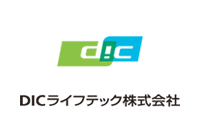
DIC Lifetech Co., Ltd
Igarashi Seimen Co., Ltd
Pompadour Co., Ltd
Imena
SANSHU SEIKA CO.,LTD.
JUKEI-HANTEN Co.,Ltd.
Contact and Inquiry
Nutrition Project Team
Nihonbashi-Honcho 2-3-11, Nihonbashi Life Science Bldg. 5F
Chuo-ku, Tokyo 103-0023
TEL: 03-6225-2795
Email:supirulina@allianceforum.org
Reference
- About Malnutrition
- Spirulina Efficacy Study on Child Malnutrition FR


